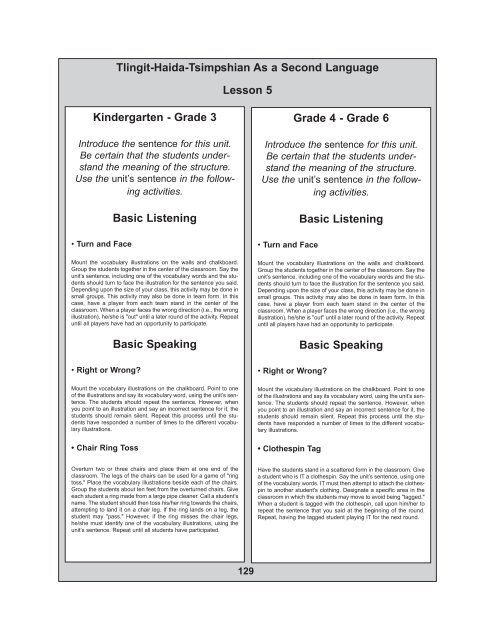Download - Sealaska Heritage Institute
Download - Sealaska Heritage Institute
Download - Sealaska Heritage Institute
Create successful ePaper yourself
Turn your PDF publications into a flip-book with our unique Google optimized e-Paper software.
Tlingit-Haida-Tsimpshian As a Second Language<br />
Lesson 5<br />
Kindergarten - Grade 3<br />
Introduce the sentence for this unit.<br />
Be certain that the students understand<br />
the meaning of the structure.<br />
Use the unit’s sentence in the following<br />
activities.<br />
• Turn and Face<br />
Basic Listening<br />
Mount the vocabulary illustrations on the walls and chalkboard.<br />
Group the stu dents together in the center of the classroom. Say the<br />
unit’s sentence, including one of the vo cabulary words and the students<br />
should turn to face the illustration for the sentence you said.<br />
Depending upon the size of your class, this ac tivity may be done in<br />
small groups. This activity may also be done in team form. In this<br />
case, have a player from each team stand in the center of the<br />
classroom. When a player faces the wrong di rection (i.e., the wrong<br />
il lustration), he/she is "out" until a later round of the ac tivity. Repeat<br />
until all players have had an opportunity to participate.<br />
• Right or Wrong<br />
Basic Speaking<br />
Mount the vocabulary illustrations on the chalkboard. Point to one<br />
of the illustra tions and say its vocabulary word, using the unit’s sentence.<br />
The students should repeat the sentence. However, when<br />
you point to an illustration and say an incorrect sentence for it, the<br />
students should remain silent. Repeat this process until the stu -<br />
dents have re sponded a number of times to the dif ferent vocabulary<br />
illustrations.<br />
• Chair Ring Toss<br />
Grade 4 - Grade 6<br />
Introduce the sentence for this unit.<br />
Be certain that the students understand<br />
the meaning of the structure.<br />
Use the unit’s sentence in the following<br />
activities.<br />
• Turn and Face<br />
Basic Listening<br />
Mount the vocabulary illustrations on the walls and chalkboard.<br />
Group the stu dents together in the center of the classroom. Say the<br />
unit’s sentence, including one of the vo cabulary words and the students<br />
should turn to face the illustration for the sentence you said.<br />
Depending upon the size of your class, this ac tivity may be done in<br />
small groups. This activity may also be done in team form. In this<br />
case, have a player from each team stand in the center of the<br />
classroom. When a player faces the wrong di rection (i.e., the wrong<br />
il lustration), he/she is "out" until a later round of the ac tivity. Repeat<br />
until all players have had an opportunity to participate.<br />
• Right or Wrong<br />
Basic Speaking<br />
Mount the vocabulary illustrations on the chalkboard. Point to one<br />
of the illustra tions and say its vocabulary word, using the unit’s sentence.<br />
The students should repeat the sentence. However, when<br />
you point to an illustration and say an incorrect sentence for it, the<br />
students should remain silent. Repeat this process until the stu -<br />
dents have re sponded a number of times to the dif ferent vocabulary<br />
illustrations.<br />
• Clothespin Tag<br />
Overturn two or three chairs and place them at one end of the<br />
class room. The legs of the chairs can be used for a game of "ring<br />
toss." Place the vocabulary illustrations beside each of the chairs.<br />
Group the students about ten feet from the overturned chairs. Give<br />
each student a ring made from a large pipe cleaner. Call a student’s<br />
name. The student should then toss his/her ring towards the chairs,<br />
attempting to land it on a chair leg. If the ring lands on a leg, the<br />
student may "pass." However, if the ring misses the chair legs,<br />
he/she must identify one of the vocabulary illustrations, using the<br />
unit’s sentence. Repeat until all students have participated.<br />
Have the students stand in a scattered form in the classroom. Give<br />
a student who is IT a clothespin. Say the unit’s sentence, using one<br />
of the vocabulary words. IT must then attempt to attach the clothespin<br />
to another student's clothing. Designate a specific area in the<br />
classroom in which the students may move to avoid being "tagged."<br />
When a student is tagged with the clothes pin, call upon him/her to<br />
repeat the sen tence that you said at the begin ning of the round.<br />
Repeat, having the tagged student playing IT for the next round.<br />
129
















